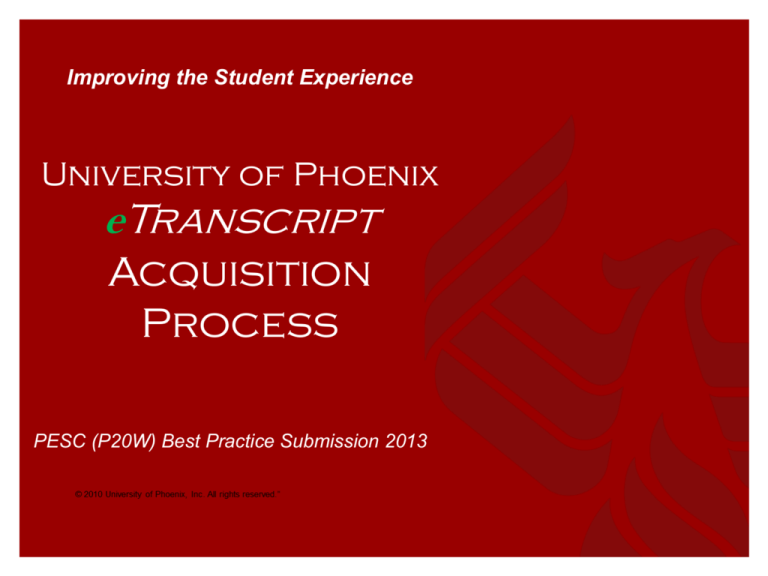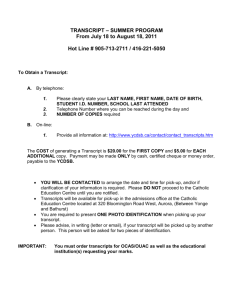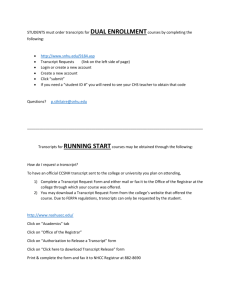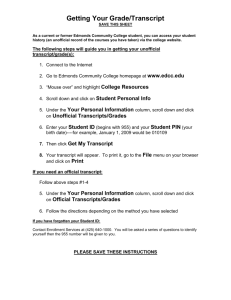
Improving the Student Experience
University of Phoenix
eTranscript
Acquisition
Process
PESC (P20W) Best Practice Submission 2013
Who We Are
•
We were founded in 1976 by Dr. John Sperling
•
We are the largest private accredited university in the United States
•
Our mission is to provide access to higher education opportunities that enable students
to develop the knowledge and skills necessary to achieve their professional goals,
improve the productivity of their organization and provide leadership and service to their
communities
•
Our vision is to offer an innovative approach to higher education focused on meeting the
needs of working students…
Convenient
Accessible
Up-to-Date
Applicable to Real World
•
Our Philosophy is reflected in many areas throughout UOPX…
Flexible Scheduling
Faculty with Real World Experience Theoretical Expertise
Centralized Curriculum Design
Innovative Student Services
© 2010 University of Phoenix, Inc. All rights reserved.”
Best Practice: electronic Transcript Acquisition
Process (eTAP)
Best Practice Process: electronic Transcript
Acquisition Process
eTAP - Transcripts are requested and/or received on behalf of
prospective students via electronic methods from prior attended
institutions
PESC EDX Standards Applied: EDI & XML
EDI Transaction Sets - TS146 Request for Transcript,
TS147 Response to Request for Transcript, TS131 Transcript
Acknowledgment, TS997 Functional Acknowledgment and
TS130 Transcript
XML Transcript
© 2010 University of Phoenix, Inc. All rights reserved.”
3
Why eTAP?
“At University of Phoenix a transcript is considered more to us than
just an academic record. It is the key to the door that provides access to
future academic achievement and life-changing outcomes. Because of
this belief we challenge ourselves to continually improve our process
year over year. This focus on process improvement, coupled with our
drive to innovate and remain agile, has led the University to become
one of the pioneers for acquiring transcripts from previously attended
institutions on our student’s behalf, and implementing a variety of
electronic transcript exchange methodologies.”
Marc Booker, Sr. Director, Office of Admissions & Evaluation
© 2010 University of Phoenix, Inc. All rights reserved.”
Shifting the Paradigm
Traditionally, students are responsible for acquiring their academic
transcripts from prior Institutions
Prior to applying to a college or University official academic transcripts from
previously attended institutions are required for admissions processing
Academic transcripts have a significant impact on key downstream processes
such as transfer credit evaluation, admissibility, scheduling and financial aid
UOPX has shifted this paradigm by providing Transcript Acquisition
Services on behalf of students
Providing this service to students at the beginning of their academic journey
removes an administrative burden and enables UOPX to decrease the amount
of time required to obtain official transcripts
This enables students to complete the admissions process efficiently by
speeding up the admission decision and transfer credit evaluation
Ultimately this allows students to begin their academic journey without the
delays often experienced by more traditional processing methods
© 2010 University of Phoenix, Inc. All rights reserved.”
EDX Movement
Around 2007-2008 the electronic transcript movement was finally
catching on in education
Due to the efficiencies and increased security associated with
electronic data exchange (EDX) UOPX began to shift focus toward this
innovative path
EDX benefits to the student…
Improves timeliness in processing of academic records
Improves accuracy in routing and processing academic records
Improves security and protects sensitive student information
EDX benefits to institutions…
Decreases risk of exposing sensitive student information
Decreases risk of acceptance of fraudulent credentials
Decreased operating cost and increased staffing efficiencies
Reduces errors due to automation of manual processes
Improves relationships between institutions by reducing burden
associated with manual processes
Reduces rework associated with delays in traditional processing
© 2010 University of Phoenix, Inc. All rights reserved.”
A Culture of
Continuous Improvement
EDX is not as simple as the flip of a switch, there are different
challenges for each institutions to overcome. Each institution needs to
identify a path that makes sense for their students based on their feeder
institutions, technological capabilities, budget and resources. At
University of Phoenix we have been driving toward EDX processing
efficiencies for many years
Our Guiding Principles
1. Process Academic Transcript Requests Efficiently
2. Actively Engage in Electronic Transcript Exchange Partnerships
3. Ensure Integrity in Processing Student’s Academic Records
© 2010 University of Phoenix, Inc. All rights reserved.”
Guiding Principle 1: Process Academic
Transcript Requests Efficiently
eTAP has enabled the Office of Admissions to shave several days off the processing time once
transcripts arrive and eliminates mail float time. We currently process and route transcripts for
evaluation within 1 business day 99.8% of the time!
© 2010 University of Phoenix, Inc. All rights reserved.”
Guiding Principle 1: Process Academic
Transcript Requests Efficiently
Our commitment to
flexibility in
implementing various
types of electronic
requesting and
receiving
methodologies enables
UOPX to maximize
efficiency by increasing
the volume of
transcripts that can be
requested and received
electronically
Key
Web-EM = institution web or
encrypted email no fee
Vendors = variety of electronic
methods (web & EDI)
P.Card = institution web, fax, or
encrypted email order with credit
card payment
© 2010 University of Phoenix, Inc. All rights reserved.”
Guiding Principle 2: Actively Engage in Electronic
Transcript Exchange Partnerships
Our eTAP Team structure enables us to focus on increasing electronic transcript partnerships
© 2010 University of Phoenix, Inc. All rights reserved.”
Guiding Principle 2: Actively Engage in Electronic
Transcript Exchange Partnerships
Our Strategy to Increase Partnerships
Assign Institutional Liaisons to focus on EDX relationships
Speak to institutions about EDX benefits during transcript follow up
Implement sound EDX practices
Explore all vendor service offerings
Remain flexible in implementing various methods of electronic exchange
Participate and network in AACRAO and P20W
Participate in standards development through P20W workgroups
Promote EDX by presenting EDX topics at conferences
Participate in EDX testing with institutions and vendors
© 2010 University of Phoenix, Inc. All rights reserved.”
Guiding Principle 2: Actively Engage in Electronic
Transcript Exchange Partnerships
Our Partnership Results: So far for 2014 we are at 1847 partners. We consider
any institution we can order and/or receive transcripts from via any electronic
method a partner
© 2010 University of Phoenix, Inc. All rights reserved.”
Guiding Principle 2: Actively Engage in Electronic
Transcript Exchange Partnerships
Our EDX Volume Results: In FY13 we requested 107,210 transcripts
electronically or 59% of total transcripts requests initiated (181,782)
© 2010 University of Phoenix, Inc. All rights reserved.”
Guiding Principle 2: Actively Engage in Electronic
Transcript Exchange Partnerships
Our EDX Volume Results: In FY13 we received 66,780 transcripts electronically or
34% of total transcripts received (196,414)
© 2010 University of Phoenix, Inc. All rights reserved.”
Guiding Principle 3: Ensure Integrity in Processing
Student Academic Records
The eTAP Team
creates and
updates institution
profiles to improve
efficiency, decrease
errors and eliminate
redundant research.
To date the team
has created and
maintains over
10,000 postsecondary and high
school profile
pages.
Permission to use this example
received from The Ohio State
University
© 2010 University of Phoenix, Inc. All rights reserved.”
Guiding Principle 3: Ensure Integrity in Processing
Student Academic Records
The eTAP Team facilitates Trading Partner Agreements to ensure student
academic transcripts are handled according to the agreed upon protocols.
There are several benefits to implementing these agreements:
•
Valuable starting point to foster trust and develop relationships
•
Clarification of expectations prior to testing/implementation
•
Documentation of details necessary to facilitate WIN WIN partnerships
•
•
•
•
•
•
•
Points of contact
Connectivity guidelines
What is considered official
Testing requirements
Financial arrangements (if applicable)
Elements and transactions that are required vs. optional
Data clarification
© 2010 University of Phoenix, Inc. All rights reserved.”
People Make Technology Work
Our people on the eTAP Team make EDX work through
their daily efforts
•
Our staff and leaders are responsible for process analysis, feedback,
and implementing improvements to ensure the eTAP is working for
customers
•
Subject Matter Experts (SME’s) are empowered to work collaboratively
and focus on refinements and innovations
•
We keep the big picture in mind and remain aligned with industry
standards by participating in P20W workgroups
•
We promote the adoption and implementation of electronic transcript
exchange through participation in AACRAO Conferences and
involvement with the AACRAO SPEEDE Committee
© 2010 University of Phoenix, Inc. All rights reserved.”
eTAP Improvement Timeline
•
Pilot to Centralize
Transcript Acquisition
in the Office of
Admissions
Acceptance of Official
PDFs
Implemented receipt
of TS130 - EDI
Transcript (Vendor
Based )
2007
•
•
2008
Institution Profiles to
track institutional
preferences for eTAP:
reduces redundant
research and
contributes toward
efficiency and
accuracy in
processing requests
•
TS130 - EDI & XML
Transcript Receipt
(Homegrown)
TS131, TS997
Acknowledgments
(Homegrown)
TS146-EDI Transcript
Request
(Homegrown)
2009
•
EDI Outbound TS130
(Homegrown)
EDI TS147
Response to Request
(Homegrown)
2010
Integration of TS130 EDI Transcript Data
with SIS: eliminated
manual process step
of transcript data entry
2011
Transcript Tracker
SharePoint dashboard
internally to enable all
UOPX campuses
visibility to the eTAP
process flow (ordered,
received, hold, no
record, evaluated)
2012
Focused on building
additional Trading
Partner Relationships:
UOPX has a widely
disbursed campus
structure with no
specific feeders which
requires us to seek
out EDX opportunities
across all institutions
2013
2014
Exploration
eSignature for
transcript requests
when TS146 is not
an option,
Vendor roadmap
enhancements to
improve ordering
efficiencies and
data usage
Southwest Alliance for Excellence
Transcript Acquisition Process
Award Recipient 2013
SWAE Award Winners
2013
http://www.swae.org/SQA
_Program/awardwinners.
htm
Yahoo Finance Article
http://finance.yahoo.com/
news/university-phoenixrecognized-2013showcase000200401.html
Article in Capitol Arizona Times Jan 31, 2014 Vol.115 Issue 5
UOPX
© 2010 University of Phoenix, Inc. All rights reserved.”
Contact
Monterey Sims
Director of Admissions & Evaluation
University of Phoenix
Office of Admissions & Records
3201 E. Elwood Phx AZ 85034 Mail Stop CF-A206
phone: 602.557.6201
fax: 480.643.1509
email: monterey.sims@phoenix.edu
1.
© 2010 University of Phoenix, Inc. All rights reserved.”







